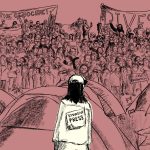The American dream is always associated with the idea of a suburban home with a white picket fence. The stereotypical home remains a dream, however, as housing policy after housing policy firmly reminds us.
San Francisco, a city racked with housing dilemmas, indicated a move in the right direction after the U.S. Department of Housing and Urban Development announced an “anti-displacement” preference for residents applying for federally financed housing. The point of contention surrounds the construction of the Willie B. Kennedy Apartments being constructed in the Western Addition section of the city, an outlying neighborhood in the throes of gentrification. The complex itself is partially federally funded.
The policy would allot 40 percent of the development for seniors from “the Western Addition, Bayview, Russian Hill, Mission and South of Marker neighborhoods,” according to an NPR article. The majority of residents in the Western Addition are African American, bringing equal opportunity of all races into the question.
Gentrification is a curious thing. We see it every day in Boston, as our rents increase, a trendy cafe pops up on the corner and it’s game over. Our “struggle” needs perspective. We move in on the first of September and leave sometime before July. We are not permanent residents, we have the means to pay for high rents and we’re willing to live in squalid conditions. We are students, and we are ruining the lives of residents.
The diaspora of students is particularly seen around Allston, which is perceived as one of the last bastions of affordable living within city limits. Walking to class, one may pass a family putting a child on a school bus. Though one may also see this in Brookline, the margin of rents between the proximal neighborhoods is astounding. Before long, that family living in Allston because of the affordable rent will most likely be gone.
Other unique areas, like Chinatown, exist because of affordable housing. If it were to disappear, massive groups of people would be without a home and without an identity. Since the days of Ellis Island, like individuals have flocked to certain neighborhoods. But because of the extreme lengths people will go to live around metropolitan areas, these cultural strongholds are quickly vanishing.
Much of Boston seems to be extremely racially homogenous, and the parts that do not fall under this characterization seem to be experiencing gentrification. Though San Francisco’s policy instigates conversation, it is missing a larger point.
The issue is already deeply rooted if individuals are applying for federally funded housing; it means they have no choice. By providing federally funded housing for gentrified areas, those residents, primarily minorities, have already been displaced from their homes. A substantive solution needs to be discovered before the crisis reaches this critical point.
Yet, as is the case with many systemic societal issues, this is merely one link in the chain being pulled above the water. To see the whole, and how interconnected the links are, you must pull the whole chain above the water. Race, inevitably, is interwoven through things like education, employment and, of course, housing.
San Francisco’s HUD is initiating conversation around affordable housing, and acknowledging the fact that race is a major part of it. This is good. But what about the next 10 years?
The Willie B. Kennedy Apartments will be built, and hopefully some seniors from the Western Addition will happily move in. But their minority children also need a home. And a job. And an education. The list goes on, and the interconnectedness of societal flaws is not going to magically dissipate. But perhaps we can take it one link at a time.




